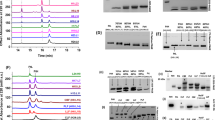Abstract
RECENTLY it was postulated that in hæmoglobin and myoglobin the hæm iron is bound to the apoprotein other than through histidine imidazole groups1. This conclusion, which does not appear to be warranted by evidence at present available, is based on the assumption that the pH at which half the hæm is bound to the protein moiety can be identified with the pKL of the binding group. There is no theoretical reason why this should be so.
This is a preview of subscription content, access via your institution
Access options
Subscribe to this journal
Receive 51 print issues and online access
$199.00 per year
only $3.90 per issue
Buy this article
- Purchase on Springer Link
- Instant access to full article PDF
Prices may be subject to local taxes which are calculated during checkout
Similar content being viewed by others
References
O'Hagan, J. E., Nature, 183, 393 (1959).
Cohn, E. J., Green, A. A., and Blanchard, M. H., J. Amer. Chem. Soc., 59, 509 (1937).
Wyman, J., “Adv. Protein Chem.”, 4, 464 (1948).
Küster, W., and Koppenhöfer, G. F., Z. Physiol. Chem., 170, 106 (1927).
Conant, J. B., “Harvey Lectures”, 28, 159 (1932–1933).
Haurowitz, F., “Chemistry and Biology of Proteins”, 208 (Academic Press, Inc., N.Y., 1950).
Author information
Authors and Affiliations
Rights and permissions
About this article
Cite this article
FALK, J., PHILLIPS, J. & PERRIN, D. Banding of Hæm to Protein in Hæmoglobin and Myoglobin. Nature 184, 1651–1652 (1959). https://doi.org/10.1038/1841651b0
Issue Date:
DOI: https://doi.org/10.1038/1841651b0
Comments
By submitting a comment you agree to abide by our Terms and Community Guidelines. If you find something abusive or that does not comply with our terms or guidelines please flag it as inappropriate.



